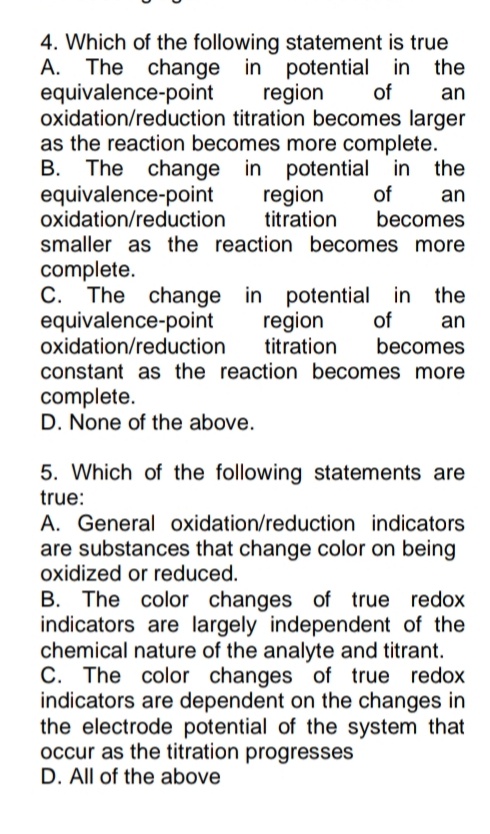4. Which of the following statement is true A. The change in potential in the equivalence-point region of an oxidation/reduction titration becomes larger as the reaction becomes more complete. the B. The change in potential in equivalence-point oxidation/reduction region titration of an becomes smaller as the reaction becomes more complete. C. The change in potential in the equivalence-point oxidation/reduction constant as the reaction becomes more region titration of an becomes complete. D. None of the above. 5. Which of the following statements are true: A. General oxidation/reduction indicators are substances that change color on being oxidized or reduced. B. The color changes of true redox indicators are largely independent of the chemical nature of the analyte and titrant. C. The color changes of true redox indicators are dependent on the changes in the electrode potential of the system that occur as the titration progresses D. All of the above
4. Which of the following statement is true A. The change in potential in the equivalence-point region of an oxidation/reduction titration becomes larger as the reaction becomes more complete. the B. The change in potential in equivalence-point oxidation/reduction region titration of an becomes smaller as the reaction becomes more complete. C. The change in potential in the equivalence-point oxidation/reduction constant as the reaction becomes more region titration of an becomes complete. D. None of the above. 5. Which of the following statements are true: A. General oxidation/reduction indicators are substances that change color on being oxidized or reduced. B. The color changes of true redox indicators are largely independent of the chemical nature of the analyte and titrant. C. The color changes of true redox indicators are dependent on the changes in the electrode potential of the system that occur as the titration progresses D. All of the above
Chapter22: Bulk Electrolysis: Electrogravimetry And Coulometry
Section: Chapter Questions
Problem 22.33QAP
Related questions
Question

Transcribed Image Text:4. Which of the following statement is true
A. The change the
in potential in
equivalence-point
region
of
an
oxidation/reduction titration becomes larger
as the reaction becomes more complete.
the
in potential in
B. The change
equivalence-point
oxidation/reduction
region
titration
of
an
becomes
smaller as the reaction becomes more
complete.
C. The change in potential in
equivalence-point
oxidation/reduction
constant as the reaction becomes more
the
of
region
titration
an
becomes
complete.
D. None of the above.
5. Which of the following statements are
true:
A. General oxidation/reduction indicators
are substances that change color on being
oxidized or reduced.
B. The color changes of true redox
indicators are largely independent of the
chemical nature of the analyte and titrant.
C. The color changes of true redox
indicators are dependent on the changes in
the electrode potential of the system that
occur as the titration progresses
D. All of the above
Expert Solution
This question has been solved!
Explore an expertly crafted, step-by-step solution for a thorough understanding of key concepts.
Step by step
Solved in 2 steps

Knowledge Booster
Learn more about
Need a deep-dive on the concept behind this application? Look no further. Learn more about this topic, chemistry and related others by exploring similar questions and additional content below.Recommended textbooks for you


Principles of Instrumental Analysis
Chemistry
ISBN:
9781305577213
Author:
Douglas A. Skoog, F. James Holler, Stanley R. Crouch
Publisher:
Cengage Learning



Principles of Instrumental Analysis
Chemistry
ISBN:
9781305577213
Author:
Douglas A. Skoog, F. James Holler, Stanley R. Crouch
Publisher:
Cengage Learning


Chemistry: Principles and Reactions
Chemistry
ISBN:
9781305079373
Author:
William L. Masterton, Cecile N. Hurley
Publisher:
Cengage Learning